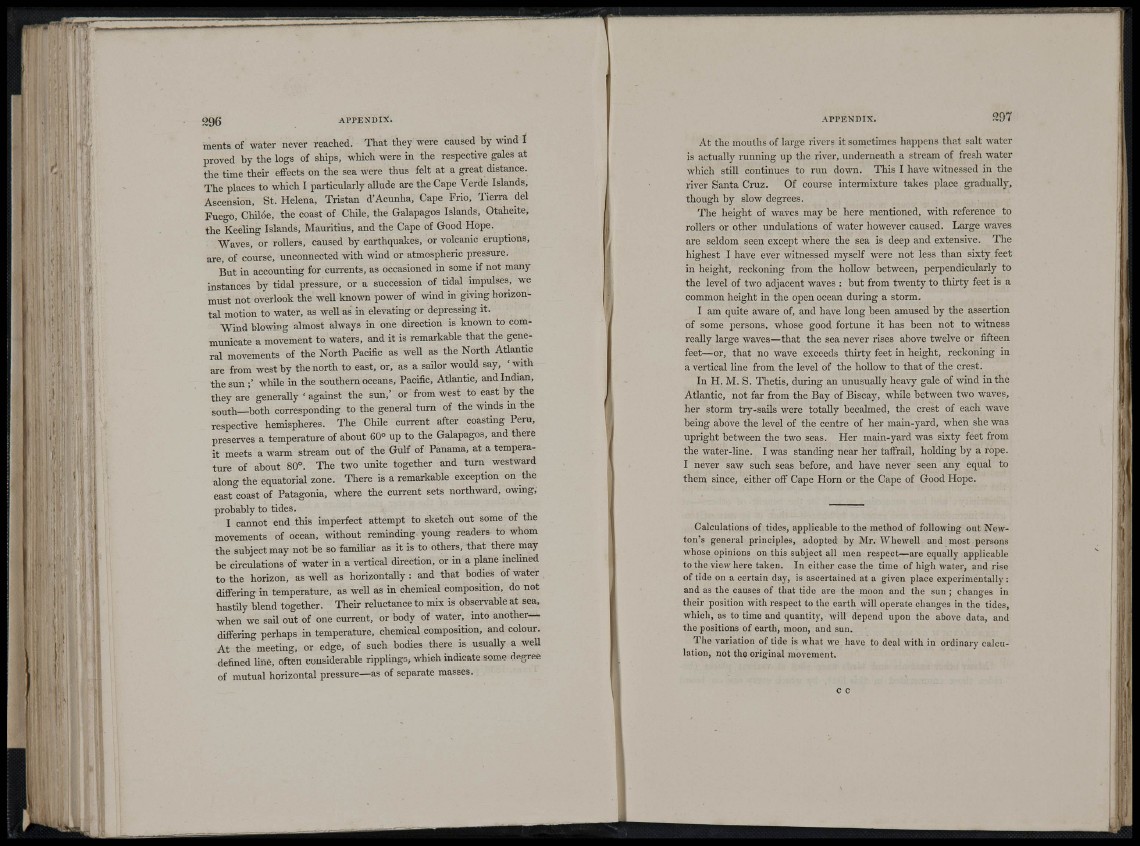
Ialini l i l i i ' i : ! It
•Mm
ili.'l'i I
296 A P P E N D I X .
raents of water never reached. That they were caused by wind I
proved by the logs of ships, wHch were in the respective gales at
the time their eifects on the sea were thus felt at a great distance.
ITie places to which I particularly allude are the Cape Verde Islands,
Ascension, St. Helena, Tristan d'Acunha, Cape Frio, Tierra del
Fuego, Chilóe, the coast of Chile, the Galapagos Islands, Otalieite,
the Keeling Islands, Mauritius, and the Cape of Good Hope.
Waves, or rollers, caused by earthquakes, or volcanic eruptions,
are, of course, unconnected with wind or atmospheric pressure.
But in accounting for currents, as occasioned in some if not many
instances by tidal pressure, or a succession of tidal impulses, we
must not overlook the weU known power of wmd in pving horizontal
motion to water, as well as in elevating or depressing it.
Wind blowing almost always in one direction is known to communicate
a movement to waters, and it is remarkable that the general
movements of the North Pacific as weU as the North Atlantic
are from west by the north to east, or, as a sailor would say, 'with
the sun while in the southern oceans. Pacific, Atlantic, and Indian,
they are generally ' against the sun,' or from west to east by the
south—both corresponding to the general turn of the winds m the
respective hemispheres. The Chile current after coasting Peru,
preserves a temperature of about 60= up to the Galapagos, and there
it meets a warm stream out of the Gulf of Panama, at a temperature
of about 80°. The two unite together and turn westward
along the equatorial zone. There is a remarkable exception on the
east°coast of Patagonia, where the current sets northward, owing,
probably to tides.
I cannot end this imperfect attempt to sketch ont some of the
movements of ocean, without reminding, young readers to whom
the subject may not be so famiUar as it is to others, that there may
be circulations of water in a vertical direction, or in a plane inclined
to the horizon, as well as horizontaUy : and that bodies of water
differing in temperature, as weU as in chemical composition, do not
hastily blend together. Their reluctance to mix is observable at sea,
when we sail out of one current, or body of water, into another—
differing perhaps in temperature, chemical composition, and colour.
At the meeting, or edge, of such bodies there is usuaUy a weU
defined Hne. often considerable ripplhigs, which indicate some degree
of mutual horizontal pressure—as of separate masses.
.APPENDIX. 297
At the mouths of large rivers it sometimes happens that salt water
is actually running up the river, underneath a stream of fresh water
which still continues to run down. This I have witnessed in the
river Santa Cruz. Of course intermixture takes place gradually,
though by slow degrees.
The height of waves may be here mentioned, with reference to
rollers or other undulations of water however caused. Large waves
are seldom seen except where the sea is deep and extensive. The
liighest I have ever witnessed myself were not less than sLxty feet
in height, reckoning from the hollow between, perijendiculai-ly to
the level of two adjacent waves : but from twenty to thirty feet is a
common height in the open ocean during a storm.
I am quite aware of, and have long been amused by the assertion
of some persons, whose good fortune it has been not to witness
really large waves—that the sea never rises above twelve or fifteen
feet—or, that no wave exceeds thirty feet in height, reckoning in
a vertical line fi-om the level of the hollow to that of the crest.
In H. M. S. Thetis, during an unusually heavy gale of wind in the
Atlantic, not far from the Bay of Biscay, while between two waves,
her storm try-sails were totally becalmed, the crest of each wave
being above the level of the centre of her main-yard, when she was
upright between the two seas. Her main-yard was sixty feet from
the water-line. I was standing near her taffrail, holding by a rope.
I never saw such seas before, and have never seen any equal to
them since, either off Cape Horn or the Cape of Good Hope.
Calculations of tides, applicable to the method of following out Newton's
{general principles, adopted by Mr. Whewell and most persons
whose opinions on this subject all men respect—are equally applicable
to the view her e taken. In either case the time of high water, and rise
of tide on a certain day, is ascertained at a given place experimentally :
and as the causes of that tide are the moon and the sun; changes in
their position with respect to the earth will operate changes in the tides,
which, as to time and quantity, will depend upon the above data, and
the positions of earth, moon, and sun.
The variation of tide is what we have to deal with in ordinary calculation,
not the original movement.